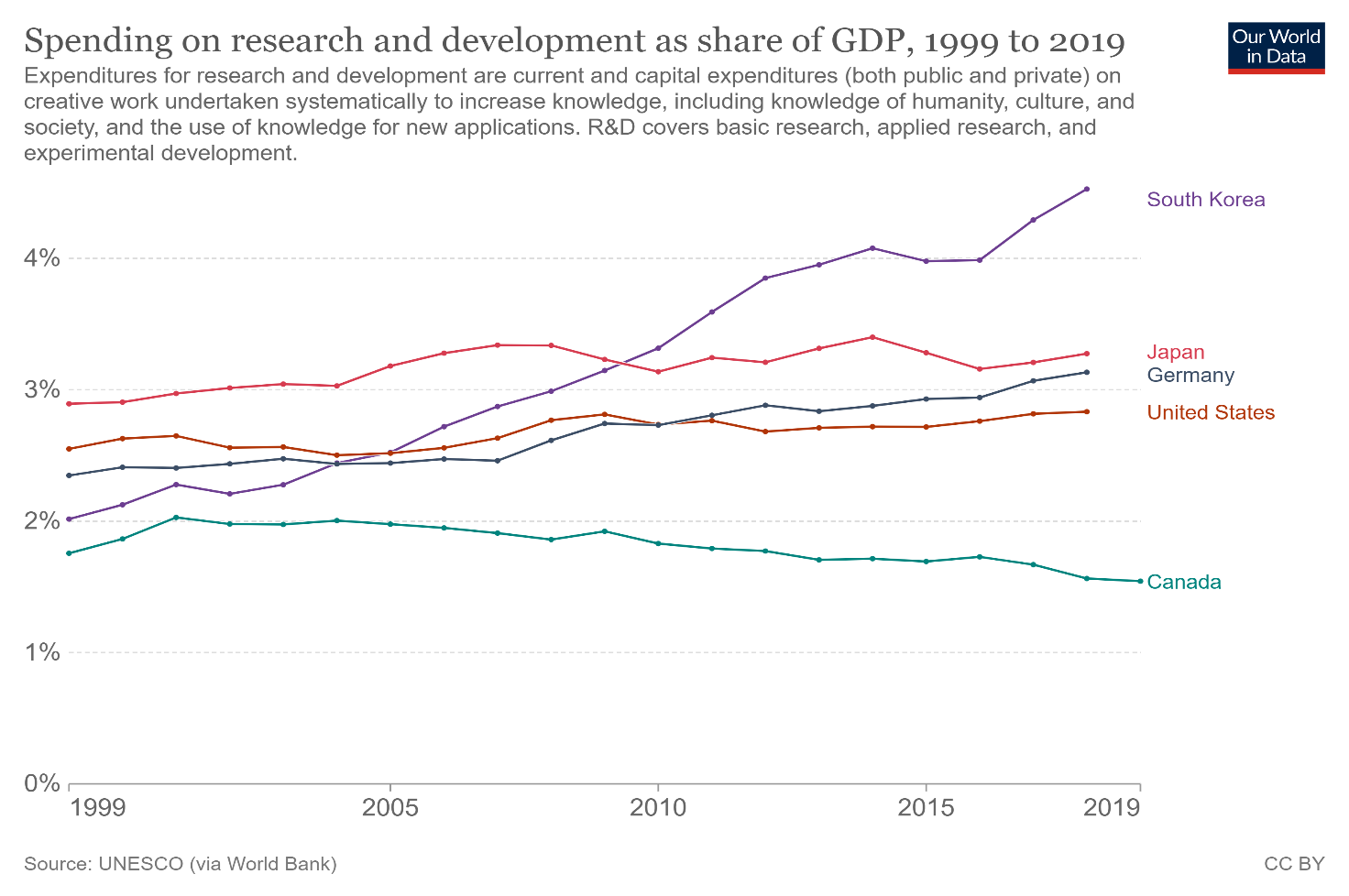
Growth, Innovation and the Organization of Science Policy in Canada
By Robert Asselin
Scientific progress is, has been and — even more so — will continue to be a key economic determinant of our future. A defining feature of modern economic growth is the systematic application of science to advance technology. Put simply, translating intellectual capital and ideas into economic output and growth will be a key determinant in how nations succeed in the modern economy. Policymakers need to acknowledge that scientific knowledge and science-based institutions are more than just public goods; they are essential economic enablers in a world of increased geopolitical competition.
Consequently, the ways we do science — how we empower our best scientists and researchers to do frontier work on the most pressing challenges we face, and how we facilitate that knowledge transfer in the real economy — must become central to how we conceptualize our growth potential as a country.
It is crucial that Canada shift its underlying policies to better support technological development and progress if we are to compete in the new highly valuable and highly competitive areas of growth and productivity.
This requires new thinking about how we conduct our industrial policy and what kinds of institutions we need to achieve it. Above all, it requires us to build absorptive capacity to ensure research translates into economic benefits.

Canada and industrial policy: A brief history
It has been said that Canada has a panoply of quasi-industrial policies but no industrial strategy. This is not new. Over several decades, Canada’s economic policy objectives have remained vague, focusing mainly on the politics of “job creation.” A country’s economy grows as a function of the expansion of its productive capacity (output per worker). Productivity is improved through innovation and technological progress.
Since the ’70s, Canada’s industrial policy approach has been essentially to:
- Create a patchwork of Crown corporations, including regional agencies, to intervene in various industries, with little or no impact on innovation and productivity, as the data shows.
- Adopt neutral incentive measures from the ’80s such as R&D tax credits across sectors and business sizes that have not resulted in increased private R&D spending.
- Provide generous subsidies and loans across all sectors of the economy through overlapping programs and agencies with no clear metrics or a coherent overarching strategy.
From a historical perspective, it is hard not to overstate the lack of focus. The issue is that it continues to this day.
Budget 2022 announced the creation of a new Innovation and Investment Agency with the mandate to “maximize business investment in research and development across all sectors and in all regions of Canada, to promote innovation-driven economic growth … The agency will seek to stimulate R&D in low-technology sectors and accelerate it in sectors that are already succeeding.” This description seems highly consistent with the history and practice of industrial policy in Canada.
Unless we put productivity enhancement and economic competitiveness as clear goals of our industrial policy, creating more structures with vague objectives is bound to yield underwhelming results.
As the Obama administration’s Strategy for American Innovation rightly noted: “The true choice in innovation is not between government and no government, but about the right type of government involvement in support of innovations. The private sector should lead on innovation, but in an era of fierce global competition, governments can and should play an important enabling role in supporting private-sector innovation initiatives.”
An effective industrial policy requires clear objectives, measurable outcomes and a focus on high-value industries that compete internationally.
The best way to consider international competition for high-value or innovative industries is to examine levels and trends in global market share of industry output or the value that is added. The Hamilton Center on Industrial Strategy Index tallied national change in global share of output in seven key industries across 10 countries between 1995 and 2018 (the last year for which OECD data were available). In a nutshell, it found Canada doing poorly, trailing Mexico on total production and global market shares, with our relative performance declining. This reflects the lack of a comprehensive policy strategy targeted at encouraging the scaling of our advanced industries. Building these advanced industries at scale is key to our future economic prosperity.

Driver of a modern industrial policy: Productivity
In an era largely characterized by secular stagnation, Canadian policymakers spent the decade following the Global Financial Crisis of 2008 trying to find ways to boost anemic demand in the economy. Despite historic low interest rates, they did so with little success. On average, real GDP growth in Canada has been hovering at two percent from 2009 to 2019. Canada is a trading nation, with exports a critical part of its growth trajectory. Unfortunately, the country’s export competitiveness weakened as its share of the U.S. market declined. USMCA, TPP and CETA notwithstanding, trade has not been a significant source of economic growth for many years. Over the last two decades, Canadian exports have risen at just half the pace of the overall economy. A key feature of that economic transition has been the over-reliance on consumer spending and residential investment. Overall, our labour productivity has been mostly flat.

In Canada, business investments in R&D have been weak (and weakening) for several decades. This can be explained by a few structural factors:
The composition of our economy: We’ve become a services/real estate economy. Canada has lost significant manufacturing capacity since the ’70s, which is not unsimilar to other OECD jurisdictions. In 2020, residential investment represented 37.2 percent of gross fixed capital formation (GFCF). To boost productivity, there is an urgent need to focus on “advanced industries.” Research by management consulting firm McKinsey & Company defines advanced industries as being characterized by deep involvement with technological innovation and STEM (science, technology, engineering and math) workers, and creating good jobs in dozens of high-value, high-technology fields. These fields range from manufacturing industries such as AgTech, cleantech and biotech to fast-growing service industries such as fintech and computer software. According to the Brookings Institution, advanced industries can be defined by two key metrics: R&D spending above the 80th percentile of Canadian industry intensity and STEM worker share of industry that exceeds the Canadian average. Advanced industries are the core of Canada’s high-value economy. They seed new technologies and innovations that help drive productivity growth throughout the rest of the economy.
An economy of SMEs: In 2019, there were roughly 1.23 million employer businesses in Canada, made up of 98 percent small businesses, two percent medium-sized businesses and 0.2 percent large businesses (500+ employees). Despite making up a fifth of a percent of all businesses, large companies contributed to nearly half (46.2 percent) of Canada’s GDP between 2012 and 2016. The evidence shows that large firms spend more on R&D, are more productive and pay higher wages.
The organization of innovation and science policy: As David Sainsbury argues in Windows of Opportunity: “Effective government policies to increase economic growth start from a recognition that innovation is the engine of economic growth; that firms innovate with the help of many other institutions, such as universities, and that public policies can either help or hinder firms’ innovation activities.”
Canada currently does not have sufficient and adequate mechanisms to translate R&D/ideas into the real economy. No matter what financial instrument is deployed, public “investments” won’t produce better outcomes if we don’t change the way we think, incentivize and produce innovation.
Being content with incremental innovation and technological adoption means Canada is leaving a considerable amount of economic wealth on the table for other countries.

A modern application of science and technology in an age of geopolitical competition
The modern application of science and technology is the new frontier of economic competitiveness. As economist Noah Smith recently wrote: “We are in a technological, economic, and arms-race competition with enemies with highly advanced tech capabilities, tons of production potential, and far fewer scruples than we have regarding the use of government power. We are not going to be able to deal with that problem by cutting taxes and opening our markets to more Chinese-made products and twiddling our thumbs and intoning quotes from Milton Friedman. Everyone except a few die-hard ideologues and vested interests realizes that on some level by now.”
Many high-income nations, including Germany, Japan, Korea, Singapore and, lately, China, have long placed bets on industrial policies to accelerate their economic growth. In the United States, the recent adoption of the Inflation Reduction Act and the CHIPS Act is quite consequential: the world’s largest economy (and Canada’s largest trading partner) has a clear strategic industrial policy for the first time since the Cold War. An injection of hundreds of billions of dollars over the next decade into targeted programs will revamp the model of U.S. science policy that has been in place since the end of the Second World War. The new direction of U.S. industrial policy reflects a broader government intervention beyond R&D to support technological development from idea to market.

The organization of science and technology as a key driver of economic competitiveness
Instead of replicating industrial strategies of the past (creating Crown corporations and giving more subsidies to firms) that have yielded sub-par results, we need to organize howour science and technology infrastructure translates ideas into the real economy.
The organization of science policy is the most overlooked feature of modern industrial policy.
Canada’s science and technology organizational structure has not adapted to the 21st century. Our capacity to undertake industrial research at scale is almost nonexistent and our technology transfer mechanisms have not kept pace with developments in knowledge creation. We still rely too heavily on incremental innovation or safe bets. Furthermore, our research strengths (mostly in social sciences) do not align with our industrial advantages and needs.
The arms-length science model we have adopted post Second World War does not provide an adequate framework for today’s economic paradigm. Under this model, it was assumed the transfer of public research to private firms would be automatic. Today, we know that funding foundational research is not a sufficient precursor to better innovation outcomes and enhanced productivity. The translation of scientific knowledge generated in universities to productivity-enhancing industrial progress has proved to be more difficult to accomplish in practice than expected. Academic influence in prestigious scholarly journals is important and should be encouraged, but so should intellectual property creation and industrial output.
The innovation ecosystem emerging from the last decades has been characterized by a deepening division of innovative labour between universities and private firms. Universities have been essentially tasked with focusing on research while industry has been left with the application of science and technology. The problem is that using the output of university research still requires significant co-ordination and integration. Universities are not well placed to translate research findings into real-life applications. To be fair, it is not their role and they have not been tasked to do this. Corporations, especially those that lack internal labs familiar with mission-oriented research, are struggling to facilitate that translation. The separation between research and application should not be underestimated.
The importance of foundational research is still paramount. Strong academic foundations — world-class research institutions and researchers — are necessary prerequisites to a well-performing innovation ecosystem. In a perfect world, foundational research and problem-oriented or mission-driven research would complement each other and work well together.
The issue is that our post-war science architecture is tilted in one direction and our R&D spending as a share of GDP has been declining over the last 20 years.

In the current configuration, the federal government provides funds for research and assumes this knowledge will naturally make its way to industry. It neglects all the necessary steps to commercialization — development, prototyping, testing, demonstration, product implementation and diffusion — that are necessary to complete the innovation process.
Venture capitalists are often portrayed as the new innovators. Although they perform an important function of seeding capital to startups, their role as “translators” of R&D in the real economy is often exaggerated given the relatively short-term financial return requirement that is common to the VC industry.
In the United States, the golden age of large industrial labs — Bell Labs, IBM, GE, DuPont — played a key role in the commercialization of R&D from the ’50s to the ’80s. But Canada never cultivated that kind of R&D industrial capacity, and where it did, like Bell Northern, it has been lost.
Ensuring research is plugged into innovation networks is a critical function of an effective industrial policy.
It took the Sputnik crisis in 1957 for the U.S. military to mobilize key innovation actors — industry, university and government — in service of the defence imperative. That led to the creation of NASA and the Defense Advanced Research Projects Agency (DARPA) in 1958. Firms don’t bolster innovation by working in isolation. They need to collaborate widely, including with suppliers, customers and post-secondary institutions. That level of co-ordination takes time, and it needs direction. DARPA’s historic track record has also made it a model of government-sponsored innovation. ARPA-E for energy and ARPA-H for health are now underway by applying the key elements of the DARPA model in other fields.
Former U.S. president John F. Kennedy’s “We choose to go to the Moon” speech at Rice University in 1962 became emblematic of a new era of public-private partnership in applied research. Recent research showed the iconic Moonshot R&D program — which was essentially an industrial research endeavour — had first-order economic effects for both local and national economies in the U.S.
The United States is not the only country that has worked diligently to institutionalize technology transfers from public R&D to industry. Germany has a wholesome and well-structured innovation ecosystem composed of key pillars: Max-Planck-Gesellschaft (foundational research), Leibniz and Helmholtz associations, Fraunhofer-Gesellschaft and the Academies of Sciences and Humanities — all of which have very strong ties to universities.
In the Netherlands, TNO, the national applied research organization, makes a major contribution to the Dutch growth strategy by developing and transferring technologies that help companies boost their productivity and retain their licence to operate.
Slow incrementalism is also an obstacle we must overcome. Except in rare cases, private actors will often not produce enough radical innovation on their own because of the high levels of risk and lengthy timelines for potential investment returns. The peer-review process for academic research funding will tend to give preference to prevailing topics, methodologies and knowledge at the expense of breakthrough ideas and technologies. The net effect is too few promising ideas make their way in the real economy. A growth fund and a new innovation agency whose missions are essentially to throw inefficient subsidies in all directions across various sectors of the economy won’t be a match for new institutional public-private arrangements that are necessary to facilitate radical innovation and enhance productivity.
Our current architecture of applied research — still functioning more or less as it has since the ’50s with legacy institutions such as the National Research Council (NRC) — is not adequate for the modern economic imperatives we are operating under.
Canada needs to build industrial research capacity at scale in innovative or advanced industries where it has structural strength; biosciences, energy, agriculture and advanced manufacturing are good examples.
Our expertise in engineering, AI, material science and genomics is now well established. We need to mobilize it in service of clear missions to solve real-life problems, amongst them climate change. The DARPA model shows public-private partnerships work when the right conditions are met.

Conclusion
We have long thought R&D was innovation. From R&D to development through production, application and diffusion, the road to innovation is long and hard. An intentional industrial policy requires a new institutional infrastructure to support the modern application of science and technology in highly competitive and advanced industries, and an approach focused on mandated missions — not diffuse curiosity-driven preferences.
Further development and integration are needed to produce inventions that can be commercialized. Converting ideas and knowledge to products, services and intellectual property remains a formidable challenge, and one that demands new approaches. Canada needs a science and technology organizational structure for the modern economy. Science is to be translated into productivity growth and future prosperity.








